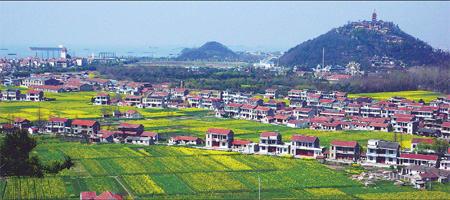Guide to Nantong, Shanghai's historic neighbor
 |
| Langshan Mountain is the best-known scenic site in Nantong, which is famous for its beautiful nature reserves and historic buildings. |
Nantong was one of the first Chinese cities to participate in a World Expo. That was more than a century ago when it won awards and praise for its wine and embroidery.
Nantong is a historic city sitting on the north bank of the Yangtze River near Shanghai. Museums, rivers, mountains and delicious seafood make it a popular tourist destination for people from Shanghai.
The city's local government has launched a series of incentives to attract more tourists, including price discounts to Expo ticket holders at many of its tourist sites. And with the Sutong Bridge Highway, completed in June 2008, Nantong is just a 90-minute drive from Shanghai and a perfect place for a weekend getaway.
Day 1
To make the most of the day, take the long-distance bus that leaves at 7:10 am. In Nantong, head to one of the top scenic spots in Jiangsu province: Langshan (or Wolf) Mountain. Consisting of five hills, it's located in the southern area of Nantong, 6 kilometers from downtown.
Some believe it is called Wolf Mountain because wolves once inhabited the area, but others say it got its name because of its wolf-like shape.
The hills and surrounding nature reserve, along with its historical relics, make it one of the most attractive regions in Nantong. On the summit of the mountain, tourists can take in extensive views of the Yangtze River together with the surrounding green valleys.
Guangjiao Temple, one of the most well-known Buddhist shrines in China, was established there more than 1,000 years ago. This huge complex consists of a diverse series of facilities and historical relics, including Zhiyun Pagoda, Zheyin Terrace, tombs, the Cuijing Buddhist Hall and many pillars and stones engraved with poetry, art and Chinese characters left by emperors, famous Buddhists, poets, politicians and writers.
In addition, the natural beauty of the hills and their surrounding scenic areas provide fabulous verdant landscapes protected by the local communities and government.
Down from the mountain, the Nantong Museum, the first public museum in China, is worth visiting. Located on the banks of the Haohe River, it was built by the famous industrialist and educationist Zhang Jian in 1905.
Set within a beautiful park, and amid historical and modern buildings, the museum's 100-year-old European-style architecture demonstrates Zhang's open-mindedness and the importance of Nantong in Chinese modern history.
The city is rich in museums with diversified exhibits. These include the China Abacus Museum, Nantong Kite Museum, Nantong Blueprint Cloth Museum and Nantong City Museum. A visit to these museums will help tourists learn more about Chinese culture.
After visiting museums and having dinner (see below for recommendations), visitors should take a trip along the Haohe River. The river is one of the most well preserved ancient moats in China. Some famous historic and cultural sites are just located on both banks of the river and, at night, these illuminated historical buildings, plus the city's modern architecture cast a delightful spell over the area.
Day 2
Take a bus to Rudong county in Nantong and enjoy picking clams on the beach. The activity attracts thousands of visitors to the small county every year.
Local people refer to clam picking as a "dancing disco on the sea". With a little hard work, lucky tourists can collect enough clams for a dinner in about 30 minutes.
During the trip, tourists can enjoy delicious Nantong food, especially its river and sea products.
Tourists can have traditional Chinese breakfast at Siyi Restaurants. Noodles, dumplings, water chestnut cake and other breakfast items with local flavor attract lots of people.
Eating seafood and river products is an important dining experience of the trip. Yipin Seafood Restaurant is famous for its fresh oysters, tuna and clams. The specialties of the Royal Badawan Restaurant are fish head soup and roasted clams. Offering all kinds of fresh seafood and river food, Jianghai Harbor Restaurant is highly recommended by locals.
 0
0 






